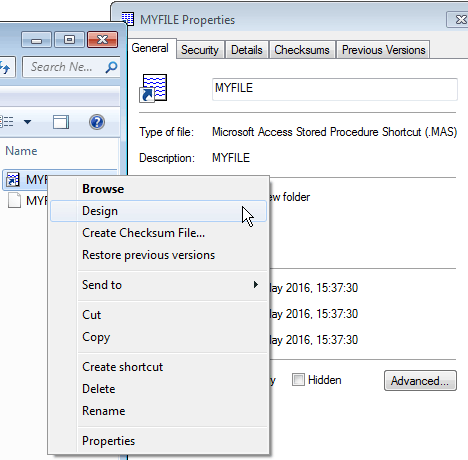3
1
I have a regular file on a Microsoft Windows 7 computer called MYFILE.MAS, as viewed from (e.g.) cmd.exe. (You can create one too, it's just an empty file). However, when viewing this file graphically with Windows Explorer, this file is treated differently than any other (e.g. to MYFILE.XYZ):
(My view options should always show file extensions). Viewing the properties and attempting to use the right-click menu is different than any other regular file:
I can't even rename the file in Windows Explorer to another extension (this needs to be done in a shell, i.e. mv MYFILE.MAS MYFILE.MAS1).
Is there a way to make Windows Explorer to treat a .MAS file extension as a regular file? I can't find any Microsoft documentation to suggest why this is happening. An no, I'm not doing anything related to Microsoft Access.
Update 1: In an attempt to remove any file associations, I've deleted the registry key, rebooted, and the key returns with these values:
[HKEY_CURRENT_USER\Software\Microsoft\Windows\CurrentVersion\Explorer\FileExts\.MAS]
[HKEY_CURRENT_USER\Software\Microsoft\Windows\CurrentVersion\Explorer\FileExts\.MAS\OpenWithList]
[HKEY_CURRENT_USER\Software\Microsoft\Windows\CurrentVersion\Explorer\FileExts\.MAS\OpenWithProgids]
"Access.Shortcut.StoredProcedure.1"=hex(0):
The last one is strange, since some automatic procedure populated the data for this registry item as a "Microsoft Access Shortcut" (aka MAS).
Update 2: I found this registry item in [HKEY_CLASSES_ROOT\.mas]:
[HKEY_CLASSES_ROOT\.mas]
@="Access.Shortcut.StoredProcedure.1"
[HKEY_CLASSES_ROOT\.mas\Access.Shortcut.StoredProcedure.1]
[HKEY_CLASSES_ROOT\.mas\Access.Shortcut.StoredProcedure.1\ShellNew]
Deleting this key (and child members), then restarting explorer.exe makes .MAS files like any other regular file. Fixed!


This is an interesting issue .. just created a new text file, renamed to "blah.mas" and have the same symptoms .. it might be an installed office shell extension that's treating the
.masextension like a shortcut of types (which explorer does not show the extension of, since shortcuts have an extension of.lnkincmd.exefor example) .. doing some more invoostigating as that's a head scratcher – txtechhelp – 2016-05-18T04:50:04.570@txtechhelp yes, this is just like a regular file
– Mike T – 2016-05-18T04:57:09.580bla.lnk, which behaves differently than other regular files. But just to Windows Explorer. This could be related to How do I “persuade” programs open an actual .lnk file in Windows 7?I feel like I'm playing an old version of some DOS game with the Windows Registry sometimes .. gotta find the hidden key to unlock the magical door before the healing fairy reveals itself .. only to find that I need the BLUE key 10 levels over :/ ..... – txtechhelp – 2016-05-18T05:05:18.567
If you have found a solution then you should post it as an answer rather than editing it into your question. – Mokubai – 2016-05-18T05:50:13.083